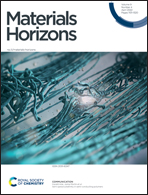A biocompatible photosensitizer with a high intersystem crossing efficiency for precise two-photon photodynamic therapy†
Abstract
Photodynamic efficiency is strongly dependent on the generation rate of reactive oxygen species (ROS) and the tissue penetration depth. Recent advances in materials science reveal that organic molecules with room-temperature phosphorescence (RTP) can potentially serve as efficient photosensitizers owing to their limited dark cytotoxicity and abundant triplet excitons upon light irradiation. In this study, we combine RTP materials with two-photon excitation to improve the ROS generation, therapeutic precision, and tissue penetration of photodynamic therapy. We successfully prepared a novel RTP-based photosensitizer (BF2DCz) with a high photoluminescence quantum yield of 47.7 ± 3% and a remarkable intersystem crossing efficiency of ∼90.3%. By encapsulation into the bovine serum albumin (BSA) matrix, BF2DCz-BSA exhibits excellent biocompatibility, negligible dark toxicity, and superior photostability. Excitation using a femtosecond laser causes BF2DCz-BSA to efficiently generate ROS and precisely exert cell damage at the desired location.



 Please wait while we load your content...
Please wait while we load your content...